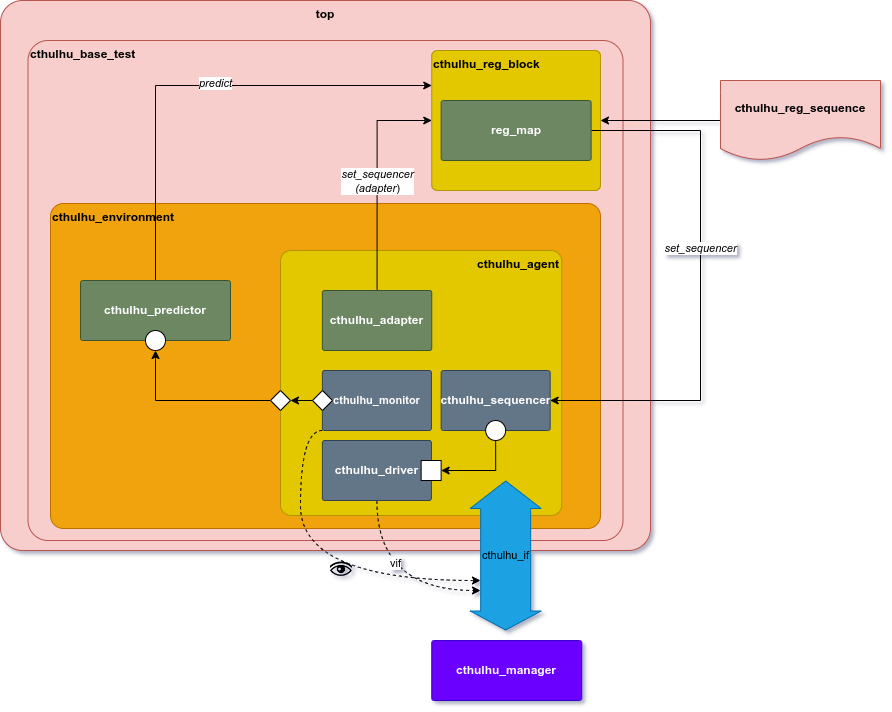A little breath
Hands-on to implement a simple UVM ambient with RAL
The missing inner components
Let's take a breath with all the new RAL stuff to see something that we already know:
Interface
DUT
Monitor
Driver
Transaction
This entire page can be skipped and the full code can be obtained at Source Code page if your only goal is to learn the RAL components. But I think it is important to know at least the interface and transaction, once the RAL commmunicates with this last one.
The Interface
The interface is very simple. The block diagram is shown below:

The functionality is very intuitive. If valid = 1'b1:
If the
write_enrises, then theaddranddata_wmust be passed together.If the
write_enis at low level, the outputdata_rwill send the reading from the addr passed byaddr.
The interface will have two clocking blocks, one to driver and another to monitor. It will also have two modports, a master and slave.
interface cthulhu_interface(input logic clk,rst_n);
logic [11:0] addr;
logic write_en;
logic valid;
logic [7:0] data_w;
logic [7:0] data_r;
clocking driver_cb @(posedge clk);
default input #1 output #1;
output addr;
output write_en;
output valid;
output data_w;
input data_r;
endclocking
clocking monitor_cb @(posedge clk);
default input #1 output #1;
input addr;
input write_en;
input valid;
input data_w;
input data_r;
endclocking
modport DRIVER (clocking driver_cb,input clk,rst_n);
modport MONITOR (clocking monitor_cb,input clk,rst_n);
endinterface : cthulhu_interfaceThe DUT
Okay, I'm not a Designer, I'm a Verifier, so ignore any bad practice in this implementation. The DUT will consist in basically two always_ff, the first will write/read from registers. The second will update the Read-only values given some conditions explained at Register Block page. So, the code will be like:
module cthulhu_manager(
input clk,
input rst_n,
input [11:0] addr,
input write_en,
input valid,
input [7:0] data_w,
output [7:0] data_r
);
life_st life;
sanity_st sanity;
status_st status;
logic [7:0] t_data;
assign data_r = t_data;
always_ff@(posedge clk, negedge rst_n) begin
if(~rst_n) begin
life <= 0;
sanity <= 0;
end
else if(write_en & valid) begin
case(addr)
12'h100: life <= data_w;
12'h200: sanity <= data_w;
default: life <= data_w;
endcase
end
else if (!write_en & valid) begin
case(addr)
12'h300: t_data <= status;
default: t_data <= 8'b0;
endcase
end
end
always_ff@(posedge clk, negedge rst_n) begin
if(~rst_n) begin
status <= 0;
end
else begin
if(life.current_health == 'h0) begin
status.is_dead <= 1'b1;
status.is_wounded <= 1'b0;
status.is_healthy <= 1'b0;
end else if(life.current_health < life.max_health/2) begin
status.is_dead <= 1'b0;
status.is_wounded <= 1'b1;
status.is_healthy <= 1'b0;
end else begin
status.is_dead <= 1'b0;
status.is_wounded <= 1'b0;
status.is_healthy <= 1'b1;
end
if(sanity.current_sanity == 'h0) begin
status.is_mad <= 1'b1;
status.is_going_mad <= 1'b0;
status.is_sane <= 1'b0;
end else if(sanity.current_sanity <= sanity.max_sanity/2) begin
status.is_mad <= 1'b0;
status.is_going_mad <= 1'b1;
status.is_sane <= 1'b0;
end else begin
status.is_mad <= 1'b0;
status.is_going_mad <= 1'b0;
status.is_sane <= 1'b1;
end
end
end
endmodule : cthulhu_managerThe Driver and monitor
There is no big deal with Driver and monitor. The complete code will be available at Source Code.
Transaction
The transaction also is very simple:
class cthulhu_transaction extends uvm_sequence_item;
rand bit [11:0] addr;
rand bit write_en;
rand bit [7:0] data_w;
rand bit [7:0] data_r;
`uvm_object_utils_begin(cthulhu_transaction)
`uvm_field_int(addr,UVM_ALL_ON)
`uvm_field_int(write_en,UVM_ALL_ON)
`uvm_field_int(data_w,UVM_ALL_ON)
`uvm_object_utils_end
function new(string name = "cthulhu_transaction");
super.new(name);
endfunction
endclassNow, our diagram is more colored:
